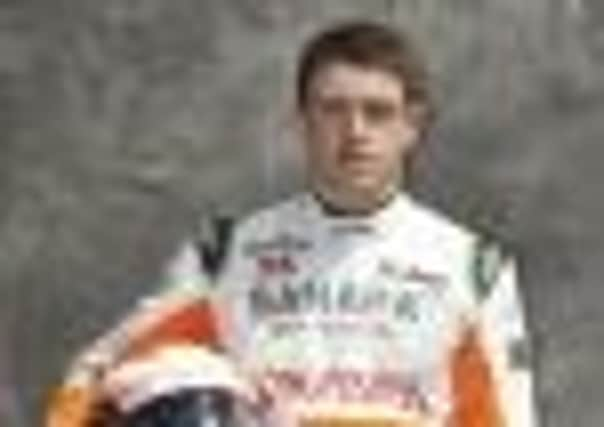Paul di Resta out to bounce back from last season


And don’t think that applies just to teams at the back of the grid. Take McLaren. This week its title sponsor, Vodafone, confirmed its exit from the sport later this year. It is perhaps no coincidence that the driver the team signed to replace former world champ Lewis Hamilton – Sergio Perez – brought with him millions of dollars from Mexican telecoms billionaire Carlos Slim.
Perez is talented: of that there is no question. But worthy of a seat in a McLaren? That’s questionable and only time will tell.
Advertisement
Hide AdAdvertisement
Hide AdMeanwhile, the driver who was long-expected to be shoe-horned into the McLaren seat vacated by Hamilton, Bathgate’s Paul di Resta, will again ply his trade this season in the Mercedes-powered Sahara Force India.
The 26-year-old Scot has already said his primary goal this season is to score his first F1 podium. What you won’t find him admitting is his desire to deliver the series of top-flight results he needs to remind everyone why he was so highly-rated when he entered the sport in 2010.
Many F1 followers have been quick to rubbish Di Resta’s 2012 performance, when he was outscored 63-46 by his then team-mate Nico Hulkenberg. What they tend to forget is that up until mid-season, Di Resta was leading the German. But then a series of disappointing results, essentially rooted in technical failings, wrecked his season. The downturn began after he’d scored a career-best fourth under the Singapore streetlights. And but for the untimely appearance of the safety car, he might have finished third.
Di Resta takes up the story. “With hindsight, we can now trace the start of the problems back to the Friday in Japan,” the Scot – 12th-fastest in yesterday’s free practice ahead of tomorrow’s opening Australian Grand Prix – explained. “[In the second practice session], I was marginally offline and on the dirt at the entry to the Spoon. Because the track had been resurfaced, it was quite difficult to see exactly where the asphalt finished, and there was loose dirt at the side of the track before the grass where people had been before.”
Such are the fine lines in F1. Di Resta’s tiny miscalculation saw him overshoot the Spoon Curve left-hander, hitting the grass with his right-hand wheel and being pitched into the barriers.
It appeared to be nothing of real significance, but the monocoque of his car had been damaged – its performance dipped and it took his team three races to identify the problem and replace the chassis. In Japan, Korea and India, Di Resta could only manage 12th in each race as he wrestled with his car. Hulkenberg, in contrast, finished sixth, seventh and eighth.
The Scot had a new car for Abu Dhabi and got back into the points in ninth.
The final race in Brazil, though, summed up the back end of his season. “We were fifth-fastest in free practice three, but just before qualifying it rained, and we didn’t gamble on a wet set-up. It rained for the race.”
Advertisement
Hide AdAdvertisement
Hide AdThen almost everything that could have gone wrong did go wrong. His front wing was damaged by Kamui Kobayashi’s Sauber, his car suffered a puncture, then he stopped for wets just before the track started drying.
Just when it couldn’t get any worse, he aquaplaned into the tyre wall at the final corner, ending his race. “No matter what I did, I just couldn’t get myself out of the rut,” Di Resta admitted. “To be honest, the season ended at exactly the right time for me.”
This weekend, refreshed, feeling fitter than ever, and fired up to not only score his first podium, but beat new team-mate Adrian Sutil, Di Resta knows he has to put himself in the shop window for the few top seats available next year at Red Bull, Ferrari and possibly McLaren.
“I’m a Sahara Force India racer this year, and my principal target is to deliver the best for the team,” he said. “I always want to achieve the best I can, where I am. I can’t do any more than that. But it’s always nice to keep your image under the nose of the other team principals, because they’re the guys who make the decisions about drivers.”
Di Resta is one of the old brigade: he doesn’t bring sponsors’ cash to discussions over race seats. Instead he has always let his driving do the talking.
Respected by McLaren team principal Martin Whitmarsh as well as Ferrari team boss Stefano Domenicali, this is the season Di Resta’s performance, and voice, must reach new heights to seal the race-winning seat his talent deserves.
SCHEDULE
Tomorrow Australian GP
24 March Malaysia GP
14 April Chinese GP
21 April Bahrain GP
12 May Spanish GP
26 May Monaco GP
9 June Canadian GP
30 June British GP
7 July German GP
28 July Hungarian GP
25 August Belgian GP
8 September Italian GP
22 September Singapore GP
6 October Korean GP
13 October Japanese GP
27 October Indian GP
3 November Abu Dhabi GP
17 November US GP
24 November Brazilian GP
DRIVERS
Red Bull Racing - Sebastian Vettel, Mark Webber
Ferrari - Fernando Alonso, Felipe Massa
McLaren - Jenson Button, Sergio Perez
Lotus - Kimi Raikkonen, Romain Grosjean
Mercedes - Nico Rosberg, Lewis Hamilton
Sauber - Nico Hulkenberg, Esteban Gutierrez
Force India - Paul di Resta, Adrian Sutil
Williams - Pastor Maldonado, Valtteri Bottas
Toro Rosso - Jean-Eric Vergne, Daniel Ricciardo
Caterham - Charles Pic, Giedo van der Garde
Marussia - Jules Bianchi, Max Chilton